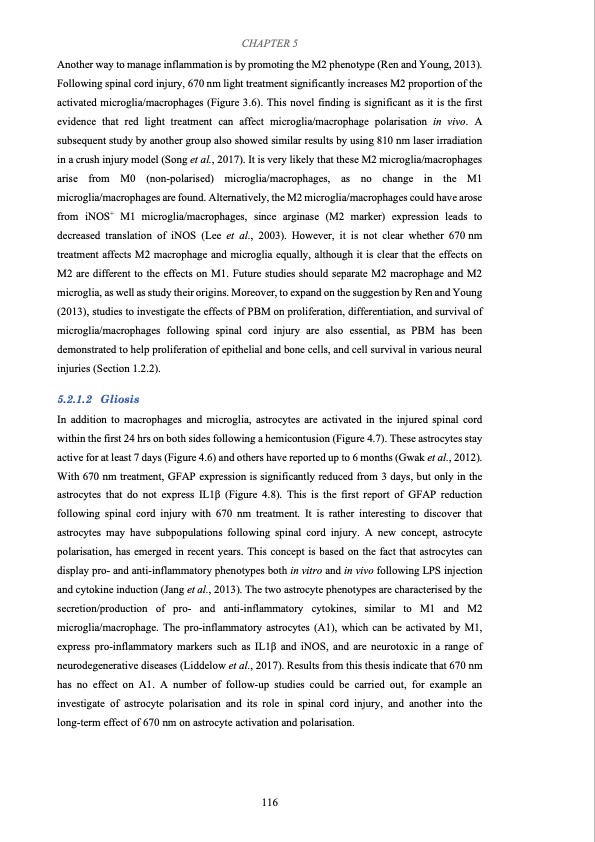
PDF Publication Title:
Text from PDF Page: 130
CHAPTER 5 Another way to manage inflammation is by promoting the M2 phenotype (Ren and Young, 2013). Following spinal cord injury, 670 nm light treatment significantly increases M2 proportion of the activated microglia/macrophages (Figure 3.6). This novel finding is significant as it is the first evidence that red light treatment can affect microglia/macrophage polarisation in vivo. A subsequent study by another group also showed similar results by using 810 nm laser irradiation in a crush injury model (Song et al., 2017). It is very likely that these M2 microglia/macrophages arise from M0 (non-polarised) microglia/macrophages, as no change in the M1 microglia/macrophages are found. Alternatively, the M2 microglia/macrophages could have arose from iNOS+ M1 microglia/macrophages, since arginase (M2 marker) expression leads to decreased translation of iNOS (Lee et al., 2003). However, it is not clear whether 670 nm treatment affects M2 macrophage and microglia equally, although it is clear that the effects on M2 are different to the effects on M1. Future studies should separate M2 macrophage and M2 microglia, as well as study their origins. Moreover, to expand on the suggestion by Ren and Young (2013), studies to investigate the effects of PBM on proliferation, differentiation, and survival of microglia/macrophages following spinal cord injury are also essential, as PBM has been demonstrated to help proliferation of epithelial and bone cells, and cell survival in various neural injuries (Section 1.2.2). 5.2.1.2 Gliosis In addition to macrophages and microglia, astrocytes are activated in the injured spinal cord within the first 24 hrs on both sides following a hemicontusion (Figure 4.7). These astrocytes stay active for at least 7 days (Figure 4.6) and others have reported up to 6 months (Gwak et al., 2012). With 670 nm treatment, GFAP expression is significantly reduced from 3 days, but only in the astrocytes that do not express IL1β (Figure 4.8). This is the first report of GFAP reduction following spinal cord injury with 670 nm treatment. It is rather interesting to discover that astrocytes may have subpopulations following spinal cord injury. A new concept, astrocyte polarisation, has emerged in recent years. This concept is based on the fact that astrocytes can display pro- and anti-inflammatory phenotypes both in vitro and in vivo following LPS injection and cytokine induction (Jang et al., 2013). The two astrocyte phenotypes are characterised by the secretion/production of pro- and anti-inflammatory cytokines, similar to M1 and M2 microglia/macrophage. The pro-inflammatory astrocytes (A1), which can be activated by M1, express pro-inflammatory markers such as IL1β and iNOS, and are neurotoxic in a range of neurodegenerative diseases (Liddelow et al., 2017). Results from this thesis indicate that 670 nm has no effect on A1. A number of follow-up studies could be carried out, for example an investigate of astrocyte polarisation and its role in spinal cord injury, and another into the long-term effect of 670 nm on astrocyte activation and polarisation. 116PDF Image | Effects of Red Light Treatment on Spinal Cord Injury

PDF Search Title:
Effects of Red Light Treatment on Spinal Cord InjuryOriginal File Name Searched:
Thesis_Di Hu_final.pdfDIY PDF Search: Google It | Yahoo | Bing
Cruise Ship Reviews | Luxury Resort | Jet | Yacht | and Travel Tech More Info
Cruising Review Topics and Articles More Info
Software based on Filemaker for the travel industry More Info
The Burgenstock Resort: Reviews on CruisingReview website... More Info
Resort Reviews: World Class resorts... More Info
The Riffelalp Resort: Reviews on CruisingReview website... More Info
| CONTACT TEL: 608-238-6001 Email: greg@cruisingreview.com | RSS | AMP |